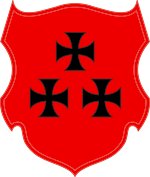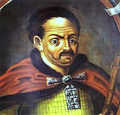إيڤان سامويلوڤتش
| إيڤان سامويلوڤتش Іван Самойлович Ivan Samoylovych | |
|---|---|

| |
| 5th هتمان القوزاق الأوكران | |
| في المنصب 17 June 1672 – 1687 | |
| سبقه | Petro Doroshenko Demian Mnohohrishny (as Moscow's appointee) |
| خلفه | إيڤان مازپا |
| تفاصيل شخصية | |
| وُلِد | 1630s Khodorkiv, Skvyra region, Polish–Lithuanian Commonwealth |
| توفي | 1690 توبولسك، سيبيريا، قيصرية روسيا |
| القومية | Ruthenian (Ukrainian) |
إيڤان سامويلوڤتش (أوكرانية: Іван Самойлович؛ روسية: Ива́н Самойло́вич؛ پولندية: Iwan Samojłowicz؛ إنگليزية: Ivan Samoylovych؛ توفي 1690) كان هتمان أوكرانيا الضفة اليسرى من 1672 حتى 1687. اتسم عهده بالمزيد من دمج هتمانية القوزاق في قيصرية روسيا وبمحاولاته انتزاع أوكرانيا الضفة اليمنى من الكومنولث الپولندي-اللتواني.
الصعود للسلطة
Samoylovych's father was a priest in a village near Zhytomyr. Ivan first rose to prominence during Ivan Briukhovetsky's revolt against Tsardom of Russia. After Briukhovetsky's execution he supported Demian Mnohohrishny as a new hetman and swore allegiance to the Russian Tsar. Securing Mnohohrishny's deposition, he was elected the Hetman of the Left-Bank Ukraine in Konotop on 17 June 1672.
Samoylovych's principal ambition was to control the Right-bank Ukraine, where two rival hetmans, Petro Doroshenko and Mykhailo Khanenko, were active. In 1674 he joined his Cossacks with the Russian forces under Prince Grigory Romodanovsky against Doroshenko. After the latter's deposition, Samoylovych let him live in peace on the left bank of the Dnieper.
زگون
In 1677, the Turkish sultan proclaimed Yuri Khmelnytsky a successor to Doroshenko, and invaded the right bank and laid siege to its capital, Chyhyryn. Although Samoylovych and Romodanovsky were generally successful in their operations against the Turks, the Russian army unexpectedly withdrew to the left bank on behest of the Tsar Alexis. By that time, the Russian government decided to de-populate the right bank altogether and to resettle its Cossacks in the areas controlled by Samoylovych. His son Semion was put in charge of these policies, known as zgon.
Conflict with Golitsyn
In 1679 Poland invited Vasily Golitsyn (prime-minister of Russia) to join the Holy League against the Turks. The Eternal Peace Treaty between Poland and Russia ran contrary with Samoylovych's plans to annex the right bank of the Dnieper, which still remained under Polish dominion since the Treaty of Andrusovo. Samoylovych attempted to persuade Russian boyars in the Polish treachery but, failing in his design, sent an angry letter to the king of Poland. Despite subsequent apologies, this incident would eventually contribute to his downfall.
In 1687, Golitsyn and Samoylovych failed in their Crimean campaigns against the Crimean Khanate on account of steppe fires. It was rumoured that it was Samoylovych who had set the steppe on fire, because he preferred the Tatars to the Poles. Golitsyn, meanwhile, was exasperated at Samoylovych's friendship with Prince Romodanovsky, his old political rival, and finally resolved to replace him with a more tractable Cossack.
In June 1687, Ivan Mazepa used the popular discontent with Samoylovych's haughty manners and high taxes to accuse him of separatism. Thereupon his youngest son, Hryhory Samoylovych, was incriminated in slandering the Tsar and executed in Sevsk. The old hetman and his family were arrested and exiled to Tobolsk in Siberia, where he died in 1690.
انظر أيضاً
وصلات خارجية
- Articles containing أوكرانية-language text
- Pages using Lang-xx templates
- Articles containing روسية-language text
- Articles containing پولندية-language text
- Articles containing إنگليزية-language text
- 1630s births
- 1690 deaths
- People from Popilnia Raion
- People from Kiev Voivodeship
- Hetmans of Zaporizhian Host
- Colonels of the Cossack Hetmanate
- Judges General of the Cossack Hetmanate
- Ukrainian exiles in the Russian Empire

